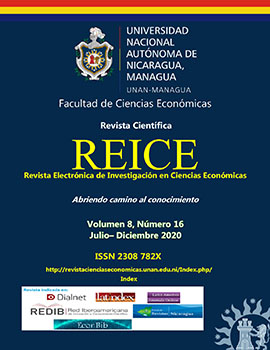Crecimiento de la productividad total de los factores en la agricultura: análisis del índice de Malmquist de 14 países, 1979-2008
DOI:
https://doi.org/10.5377/reice.v8i16.10661Palabras clave:
Crecimiento, productividad total de los factores, Índice de Malmquist, Análisis Envolvente de DatosResumen
La investigación se centró en estudiar el comportamiento de la productividad en la producción agrícola en 14 países en desarrollo de la región de Centroamérica y el Caribe. Se utilizaron datos de la Organización de las Naciones Unidas para la Agricultura y la Alimentación en el período 1979-2008. El estudio utilizó el análisis envolvente de datos (DEA) para derivar los índices de productividad de Malmquist. Se examinaron las tendencias de la productividad agrícola durante el período. Las cuestiones de la puesta al día y la convergencia, o en algunos casos la posible divergencia, en la productividad en la agricultura se examinó dentro de un marco global. 1.5% de la PTF, con el cambio de eficiencia (o puesta al día) contribuyendo con 0.1% por año y el cambio técnico (o cambio de frontera) proporcionando el otro 1.4% como resultado. El desempeño más espectacular lo presenta República Dominicana, por lo que representó 3.9% en la PTF durante el período de estudio un crecimiento anual promedio. Cuba, Barbados, Costa Rica, Panamá y Guatemala han registrado una tasa de crecimiento de la PTF de solo 2,9 cada uno.
Descargas
1023
Descargas
Publicado
Cómo citar
Número
Sección
Licencia
Copyright (c) Revista Electronica de Investigacion en Ciencias Economicas
Los derechos sobre los artículos publicados en REICE son de la revista, a los efectos de poder gestionar su mejor difusión. No obstante, puesto que la finalidad de la misma es la difusión del conocimiento, esta revista provee acceso libre inmediato a su contenido, bajo el principio de que hacer disponible gratuitamente la investigación al público, lo cual fomenta un mayor intercambio de conocimiento global.
Las opiniones expresadas por los autores no necesariamente reflejan la postura de la editora de la publicación ni de la UNAN-Managua Se autoriza su reproducción y distribución (en cualquier tipo de soporte) siempre que se cumpla las siguientes indicaciones:
- La autoría del trabajo
- Que se indique su origen (revista REICE, volumen, número y dirección electrónica del documento)

